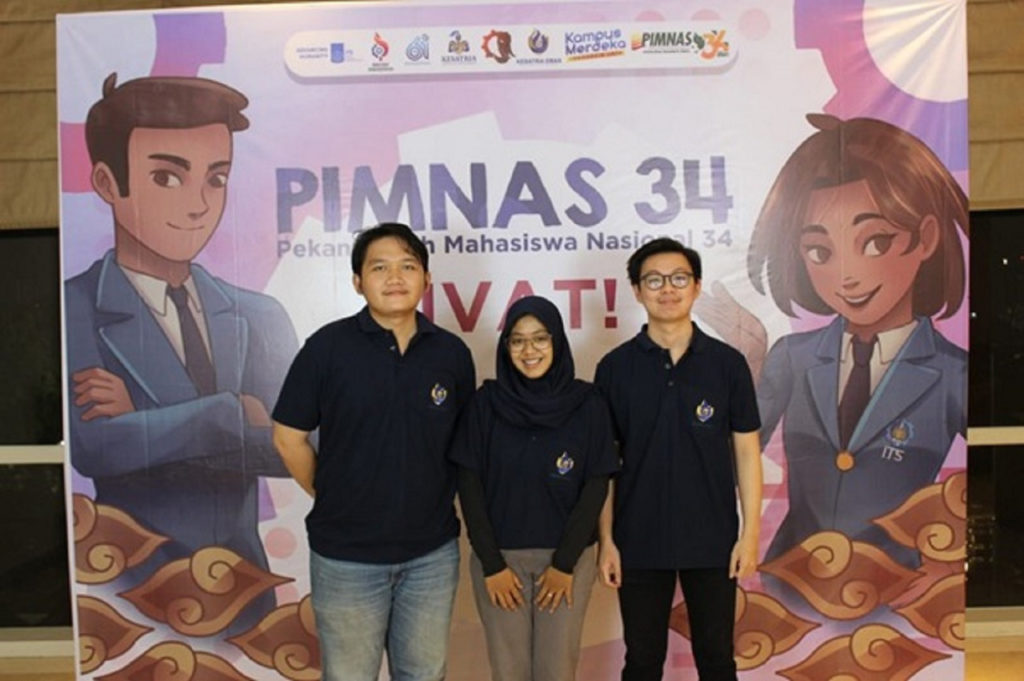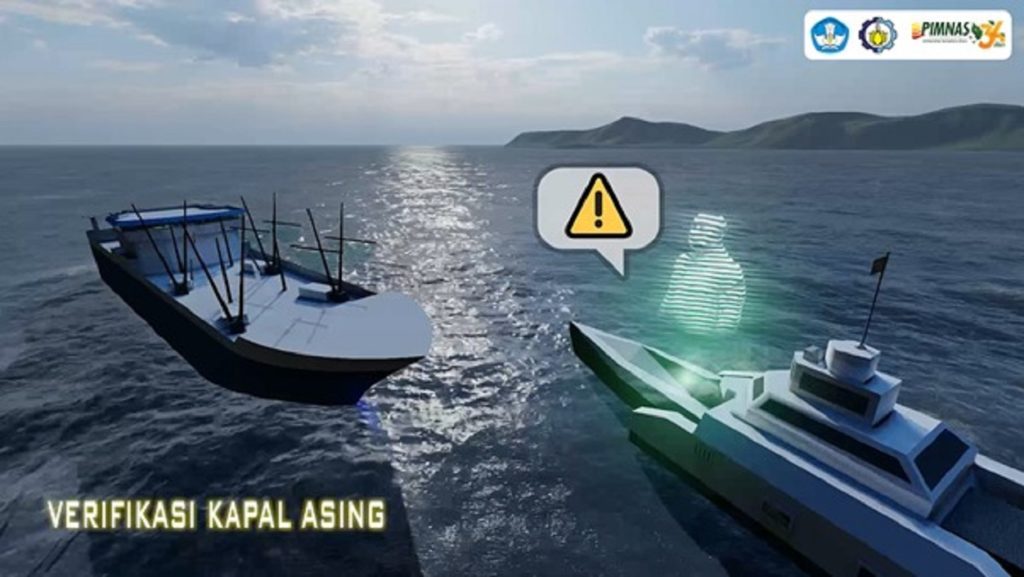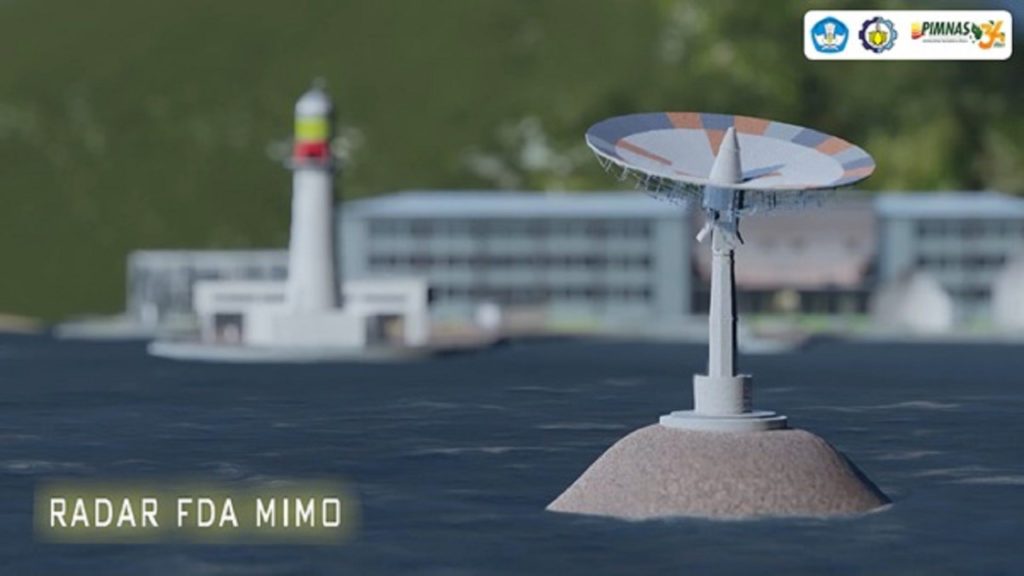ITS Students Initiate Automatic Maritime Security System

(from left) Christophorus Nathanael, Adinda Anggraeni Rahmawati S, and Adiwira Surya Susanto who are members of the ITS Adhysta Team
ITS Campus, ITS News – Throughout 2016, as many as 280 foreign vessels were detected by the government doing illegal fishing in the Natuna Sea, and the number continues to increase until now. These unlawful activities certainly cause enormous losses for the surrounding community and the state. Departing from this problem, three students of the Department of Marine Engineering, Faculty of Marine Technology (FTK) ITS initiated an innovation called the Marine Autonomous Security System.
They are Adiwira Surya Susanto, Adinda Anggraeni Rahmawati S, and Christophorus Nathanael, who are members of the Adhysta Team. The innovation they bring is a combination of three major technologies. These include uncrewed vessels, integration of a frequency diverse array multiple-input multiple-output (FDA MIMO) radar with Automatic Identification System (AIS), as well as holographic display system technology.
The FDA MIMO radar is a radar innovation with a range of 300 nautical miles that can cover the entire North Natuna Sea area. This radar works by emitting electromagnetic waves, which are then reflected by the ship. The reflected waves are then captured and tracked by radar in real-time. “From the waves, we can know the position, speed, and prediction of the target ship’s motion,” explained Adiwira Surya Susanto or who is often called Adi.

Illustration of a holographic technology design on a crewless vessel verifying illegal foreign vessels
The FDA MIMO radar, continued Adi, is integrated with AIS, a tracking system, and consists of two components: AIS trackers on ships and AIS on stations. Following the Regulation of the Minister of Transportation Number PM 7 of 2019, every ship that has a license to sail in Indonesian waters must install and turn on AIS so that ships that do not have or do not turn on AIS will be categorized as illegal foreign ships.
The Adhysta Team Leader explained that data from radar had been integrated in an ICBMS (IoT, Cloud, Big Data, Mobile, and Security) manner with crewless vessels and AIS stations. This integration allows crewless containers to come to the coordinates of foreign ships in real-time to carry out the warning process by utilizing holographic technology.

Illustration of the design of the FDA MIMO Radar model that tracks ships in territorial waters using electromagnetic waves
The hologram technology on the ship traps airborne particles and then illuminates them with a laser beam to create an image of the airspace. This image allows the verification process and remote communication between officers at the station and foreign ships. If the alien ship insists on entering, the system will call the Indonesian Maritime Security Agency (Bakamla) to follow up.
The student from South Tangerang said that the system they initiated could secure 1.6 million tons of fish from illegal fishing activities and generate a profit of Rp 24 trillion at the cost of fish export of US$ 2 per kilogram. From the security aspect, this system can increase the supervision of illegal fishing vessels by up to 85 percent.
Thanks to this innovation, the guidance team of Wimala Lalitya Dhanistha ST MT has succeeded in bringing home a gold medal at the 34th National Student Scientific Week (Pimnas) for the presentation category of the Written Ideas Student Creativity Program (PKM-GT) last October 29. “I was quite surprised and didn’t expect it because online conditions had caused miscommunication,” said Adi.
This class of 2020 student said that his team hoped that their ideas would be looked at and explored further by the government so that the Marine Autonomous Security System could spearhead the water security system in Indonesia to prevent the threat of illegal fishing. “Not only in Natuna but also in other Indonesian waters that are prone to illegal fishing,” he concluded. (ITS Public Relation/far)
Reporter: Dian Nizzah Fortuna
Related News
-
Anticipating Lost Pet Dogs, ITS Students Invent a Tracking Bag
ITS Campus, ITS News —Losing a pet is a sad thing for its owners. To anticipate this, a team
December 16, 2021 16:12 -
ITS Students Integrate Smart City Service Features Through Visionaries
ITS Campus, ITS News — Institut Teknologi Sepuluh Nopember (ITS) continues to prove itself as a home for talented
December 16, 2021 16:12 -
ITS Students Innovate Eco-Quake Building Concept
ITS Campus, ITS News — Along with the development of technology, the construction sector has also experienced rapid growth
December 16, 2021 16:12 -
Great, ITS Successfully Becomes Overall Champion of the 2024 Indonesian Ship Contest
ITS Campus, ITS News — Proving itself as a home for champions, Institut Teknologi Sepuluh Nopember (ITS) managed to
December 16, 2021 16:12
